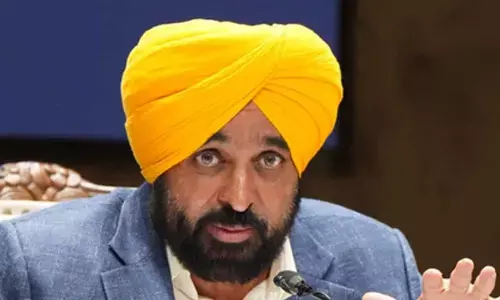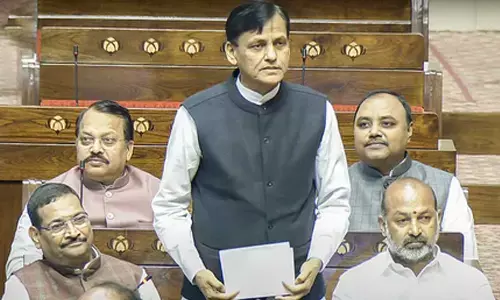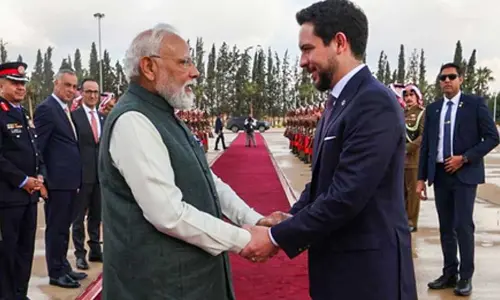The Saint and the Pope

The venerable sages of India, the Buddha, Jesus, Prophet Muhammad, Guru Nanak – the founders of all major religions – were all known to spurn material comfort and stress compassion for the weak and safeguarding nature, but not many of their followers emulated them.
The venerable sages of India, the Buddha, Jesus, Prophet Muhammad, Guru Nanak – the founders of all major religions – were all known to spurn material comfort and stress compassion for the weak and safeguarding nature, but not many of their followers emulated them.
One who did unreservedly was this Christian saint, venerated even beyond his own sect, and with such an image that nearly eight centuries later, a Pope with a vision to revitalise the church signalled his intention by adopting his name.
Both St Francis of Assisi and Pope Francis shouldn't be thought important for their own religion, or students of theology, for both have much to teach us. And there some splendid accounts that we can depend upon.
Especially St Francis of Assisi (c. 1182-1226), whose feast day falls on October 4, given how he has resonance in other religious traditions.
Then, the order he founded, with its stress on poverty, love and charity, is still influential around the world and responsible for some esteemed educational institutions (like my own alma mater, Lucknow's second-oldest existing college, St Francis, established 1885).
Like Guru Nanak, he was a trader's son but also angered his father by distributing goods to the poor; like the Buddha, or the Islamic Qalandars, he abandoned a prosperous life for peripatetic mendicancy; like the old Hindu sages, he stressed on respecting nature and revering all living creatures; and his habit of song and dance to reach religious ecstasy closely resembles the Sufi tradition of qawwali and Maulana Rumi's Whirling Dervishes. He also was Mahatma Gandhi's favourite Christian saint.
There is no shortage of books on Giovanni ‘Francesco' di Pietro di Bernardone's transition into Brother Francis (he was canonised in 1228, less than two years after his death), but among the best, even with much creative license, is Greek author Nikos Kazantzakis' ‘God's Pauper’ (1962).
Kazantzakis (1883-1957), best known for his ‘Zorba the Greek’ (1952), and ‘The Last Temptation of Christ’ (1961) – banned by the Catholic Church and earning him a threat of excommunication from his Greek Orthodox Church, tells us that if in this, he has "omitted many of Francis' sayings and deeds and if I have altered others, and added still others, which did not take place but which might have taken place, I have done so not out of ignorance or impudence or irreverence, but from a need to match the Saint's life with his myth..."
In this lyrical work, told from perspective of Francis' devoted companion Leo, some notable sections include the meeting with the Pope (Innocent III) in Rome, and prior to it, a meeting with Spanish monk Dominic, keen to find an order to safeguard the Church (demonstrating the paths between a Church Compassionate and a Church Combative).
Then there is the nearly-surrealistic meeting with Ayyubid Sultan, Kamil, in Egypt during the Fifth Crusade (differing versions of what happened exist but it must be noted it was only the Franciscans, who were allowed to stay to tend Christian sites in the Holy Land, long after the Crusades, save a brief period, till now). And the passages about his interaction with animals are superlative too.
More straightforward biographies include Fransciscan scholar Murray Bodo's ‘Francis: The Journey and the Dream’ (2011) and Dominican scholar Augustine Thompson's ‘Francis of Assisi: A New Biography’ (2012). His legacy is studied in Patricia Appelbaum's ‘St. Francis of America: How a Thirteenth-Century Friar Became America's Most Popular Saint’ (2015).
And then, the Pope – Jorge Mario Bergoglio, who became the 266th Pope in 2013, was, apart from being the first from the Americas, the first Jesuit, the first non-European in around 1,300 years (though the 12th overall), the first to chose Francis as his pontifical name – after the Saint of Assisi, though his own order also had a St Francis (Xavier).
Becoming the most famous Argentine since Juan and Eva Peron, Ernesto ‘Che' Guevara, Diego Maradonna, and Gabriela Sabatini, he had a positive impression over his humility and openness, focus on mercy, concern for poor and social justice, stress on inter-faith dialogue and a perceived liberal bent despite his conservatism in doctrine.
Interest had been growing in him since it was revealed he received some support in the 2005 papal conclave and this prompted Argentine journalist Sergio Brin to write his biography, along with Italian counterpart Francesca Ambrogetti. Although Bergoglio initially resisted, he agreed to a series of extensive interviews over two years that became ‘El Jesuita’ (2010). The only biography available, it was quickly translated into English. ‘Pope Francis: Conversations with Jorge Bergoglio: His Life in His Own Words’ (2013) reveals the person behind the cleric.
Since then there have been more, but among the most comprehensive, yet readable, is British journalist-writer Austen Ivereigh's ‘The Great Reformer: Francis and the Making of a Radical Pope’ (2014), which not only gives his history, but also of the Church, Jesuits, Argentina and South America.
A more technical (but accessible) examination of his theological challenges is American historian Gary Willis' ‘The Future of the Catholic Church with Pope Francis’ (2015).


















